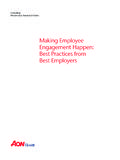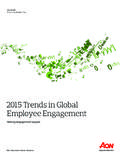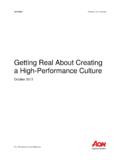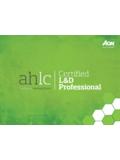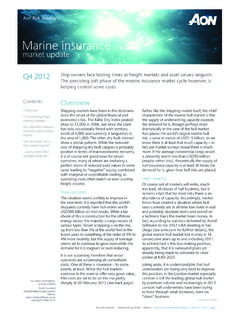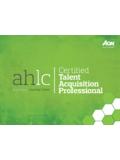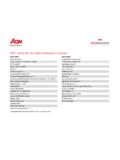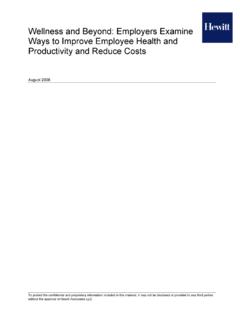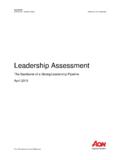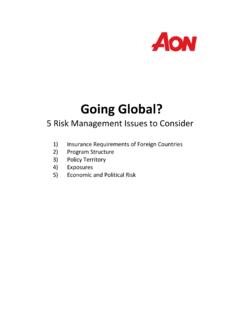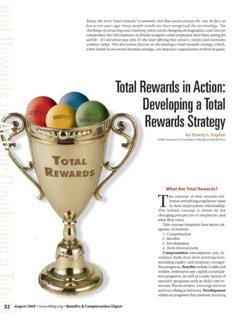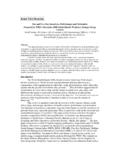Transcription of 2012 Total Rewards Survey - Aon
1 Consulting Talent & RewardsConsulting Talent and RewardsTotal Rewards Survey Transforming Potential Into Value2 012 Aon Hewitt s Total Rewards FrameworkThe Aon Hewitt 2012 Total Rewards Survey defines Total Rewards as everything an employee gets from the employer that they find rewarding ( , compensation, benefits, learning, development, etc.). This concept is depicted below:At Aon Hewitt, we use this four-quadrant model to illustrate the concept of Total Rewards . Everything an employee receives from an employer ( , not just those elements listed above as examples) can be positioned within this framework, depending on whether the reward element is: n Financial or Experiential Financial elements have a clearly defined value or cost, while experiential elements are those the employee experiences through inter action with the company, leadership, management, colleagues, and Personal or Company Some Rewards are tailored to the individual ( , salary, bonus, personal goals, development plan, etc.)
2 , while others are provided in more or less the same way to all employees ( , benefits, culture, work environment). While virtually every organization provides Rewards in each of the four quadrants, many leading companies are keenly interested in finding ways to shift more of the Total Rewards elements up and to the right. This is because we know that more personal and experiential Rewards create a stronger emotional bond between employees and the & CulturePhysical Work EnvironmentWork Life BalanceBenefitsHealth & WellnessRetirement/SavingsPaid Time OffDevelopmentCareer OpportunitiesLearning & DevelopmentGoals & CoachingCompensationBase SalaryAnnual IncentivesStock/LTI Awards12012 Total Rewards SurveyContents Transforming Potential Into Value Executive SummaryHigh AspirationsMediocre ExecutionHigh-Performing Companies Take a Different ApproachConsequences Are CostlyChange is DesiredThe Way Foward is ClearMap, Compass, Radar.
3 And Telescope39212945576575 Total Rewards Survey20122 Aon Hewitt32012 Total Rewards SurveyTransforming Potential Into Value Executive SummaryEmployers have seen the potential of Total Rewards for many years. Each year they invest vast sums on their Total reward programs, often as an inducement for talented people to join their organization, to perform at levels that produce outcomes that the employer is seeking, and to remain with the organization for as long as they continue to produce results. But, are organizations reaping the Rewards of their investment?4 Aon HewittHigh AspirationsIn the fall of 2011, Aon Hewitt conducted a Survey to gather data about organizational priorities including current and future direction of Total Rewards programs and to identify areas that require additional focus.
4 This report presents the Survey findings and Aon Hewitt s analysis and recommendations for employers seeking to more fully realize the potential of their Total Rewards programs. Interest in the Survey was high, with nearly 750 organizations participating. Overall, the Survey results suggest there is much room for improvement in how employers are managing their Total Rewards program. The responses also point to a number of areas where employers who want to improve can do so. Practices of high-performing organizations point the way toward some of the initial steps and even some of the more advanced actions that employers can take to improve the value they are getting on their Total Rewards scope and breadth of Total Rewards leads to high expectations and aspirations.
5 Survey results show that many business leaders and HR practitioners believe that when Total Rewards are properly aligned, designed, and delivered, the impact on individual engagement and organizational performance can be significant. Consequently, there is great interest in finding ways to transform the potential that Total Rewards offers as a management tool. Many organizations, however, struggle to find the right combination: n Forty-one percent of participants say they want to be managing Total Rewards as a portfolio or package; slightly less than 10% are doing this today. n One-third of companies surveyed want to see their Total Rewards as a differentiator; only 10% say they are there One-quarter of Survey respondents want to be early adopters and innovators in Total Rewards ; only 10% say they are there Rewards often represent one of the largest investments that an organization makes.
6 But what return do organizations get on that investment? Consider that 60% of companies surveyed described their engagement levels as low and two-thirds indicated that the trend in engagement is holding steady or trending downward. Other research confirms that engagement is critically low, and that churn, even amongst top performers, is Hewitt s Total Rewards SurveyMediocre Execution52012 Total Rewards SurveySo, how does such a promising concept like Total Rewards produce such abysmal results? The Survey results shed some light on that question. The answer seems to lie in how companies execute or fail to execute on their approach to Total Rewards : n No clear link to business strategy or desired outcomes Eighty-seven percent of Survey respondents indicate that it is critical to align Total Rewards strategy with business strategy; only 56% are doing so and 74% of companies do not have a strategy for managing Total Rewards .
7 N Failure to rely on hard data and metrics Only 46% of companies feel it is critical to gather facts to drive decisions on Total Rewards , and only 37% are doing so. n Not listening to employees or asking leaders While 37% of Survey respondents say it is critical to gather data from employees to manage Total Rewards , only 28% are doing so. If we dig a little deeper, we find that some organizations are getting better results. The question is: Are they doing anything differently when it comes to their approach to Total Rewards that we can learn from?The Survey results do show two major similarities between The Best and The Rest.
8 1. High-performing companies and the rest identified the same programs are most important for attracting and retaining talent, including base pay, challenging work, culture, health care benefits, etc. 2. All companies identified similar planned investment allocations in human resource programs, from retirement to pay. Survey results show that high-performing organizations do five things differently from The Rest. Articulate strategies and goalsBalance more inputs for decision-makingConnect to the business and employeesDefine effectiveness differentlyEarn better outcomesAre High-Performance Organizations Doing Anything Differently?
9 Who Are the High Performers? For this study, high performing or The Best organizations are defined as those that achieve the highest levels of:n Revenue against objectivesn Innovationn High employee engagementUsing this definition, we found 150 organizations in our study sample, representing approximately 20% of the Total number of participating organizations. Those that did not meet all three criteria are defined as The Rest. 6 Aon HewittThe Survey results identified three major consequences for companies that do not manage Total Rewards effectively:1. Missing valuable input from employees, which may lead to lower engagement and higher Missing opportunities to manage Total Rewards as a portfolio, which may lead to higher costs and lower Introducing unnecessary risk into their Total Rewards approach.
10 Failure to identify and properly manage Rewards can ultimately lead to damage to an organization s brand, loss of customers, and a reduced ability to attract and retain employees. Expanding the evaluation of Total Rewards programs to include efficiency, effectiveness, and exposure alongside competitiveness, cost and compliance, is one way companies can begin to find ways to improve the return on their Total Rewards Survey results show that these high aspirations and poor execution combine to produce a situation where much change is desired. Among Survey respondents, 55% say they believe some change will be required and an additional 38% indicate that they believe significant change will be needed in their Total Rewards in order to meet their business and workforce needs.
